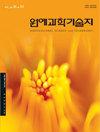Detection of Cymbidium mosaic virus and Odontoglossum ringspot virus in Phalaenopsis in Korea
IF 0.8
4区 农林科学
Q3 HORTICULTURE
Korean Journal of Horticultural Science & Technology
Pub Date : 2021-08-01
DOI:10.7235/HORT.20210046
引用次数: 0
Abstract
The primary purpose of this study was to examine the effects of virus infection in Phalaenopsis cultivated across the country. RT-PCR analysis was used to detect two major viruses in orchid: CymMV and ORSV. The virus infection rate of in vitro plantlets from 45 cultivars was 83.6%, and the rate of potted plants from 21 cultivars was 92.5%. For CymMV, single infection in in vitro plantlets was 34.3%, and for ORSV, it was 11.4%. In the case of potted plants, single infection with CymMV was 57.0%, and ORSV alone was not detected. For double infection with both viruses, in vitro plants accounted for 37.9% and potted plants for 35.5%. No infection with both viruses was found in in vitro plantlets with ‘V3’ imported from Taiwan. Plants infected with CymMV showed chlorotic and necrotic spots on leaves and color break in petals and sepals of flowers, and those infected with both CymMV and ORSV featured yellow striped or mosaic symptoms. Additional key words: CymMV, DN method, in vitro plantlets, ORSV, potted plants, RT-PCR韩国蝴蝶兰中大花蕙兰花叶病毒和舌兰环斑病毒的检测
本研究的主要目的是检测病毒感染对全国各地种植的蝴蝶兰的影响。采用RT-PCR方法检测兰花中的两种主要病毒:CymMV和ORSV。来自45个品种的试管苗的病毒感染率为83.6%,来自21个品种的盆栽植株的感染率为92.5%。对于CymMV,试管苗中的单次感染率为34.3%,ORSV为11.4%。在盆栽植株的情况下,CymMV单次感染为57.0%,并且未检测到单独的ORSV。在两种病毒的双重感染中,试管植物占37.9%,盆栽植物占35.5%,台湾进口‘V3’试管苗未发现两种病毒感染。感染CymMV的植物在叶片上表现出褪绿和坏死斑点,花瓣和萼片出现颜色断裂,同时感染CymMV和ORSV的植物表现出黄条纹或马赛克症状。附加关键词:CymMV,DN法,试管苗,ORSV,盆栽,RT-PCR
本文章由计算机程序翻译,如有差异,请以英文原文为准。
求助全文
约1分钟内获得全文
求助全文
来源期刊
CiteScore
2.00
自引率
0.00%
发文量
0
审稿时长
1 months
期刊介绍:
Horticultural Science and Technology (abbr. Hortic. Sci. Technol., herein ‘HST’; ISSN, 1226-8763), one of the two official journals of the Korean Society for Horticultural Science (KSHS), was launched in 1998 to provides scientific and professional publication on technology and sciences of horticultural area. As an international journal, HST is published in English and Korean, bimonthly on the last day of even number months, and indexed in ‘SCIE’, ‘SCOPUS’ and ‘CABI’. The HST is devoted for the publication of technical and academic papers and review articles on such arears as cultivation physiology, protected horticulture, postharvest technology, genetics and breeding, tissue culture and biotechnology, and other related to vegetables, fruit, ornamental, and herbal plants.

 求助内容:
求助内容: 应助结果提醒方式:
应助结果提醒方式:


